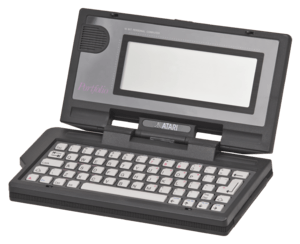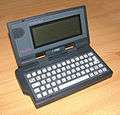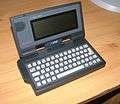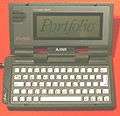Atari Portfolio
|
Atari Portfolio | |
| Also known as |
HPC-004 (ROM version: 1.056) HPC-006 (ROM version: 1.072)[1] |
|---|---|
| Type | Palmtop PC |
| Release date | June 1989 |
| Introductory price | US$399.95 (equivalent to $764.79 in 2015) |
| Discontinued | 1993 |
| Operating system | DIP DOS 2.11 |
| CPU | 80C88 @ 4.9152 MHz |
| Memory | 128 kB of RAM and 256 kB of ROM |
| Display | monochrome LCD (no backlight) 40 characters x 8 lines |
| Graphics | 240 x 64 pixels |
| Sound | Tiny speaker |
| Input | Keyboard 63 keys, QWERTY layout |
| Power | 3x AA size removable alkaline batteries (Optional AC adapter)[2] |
| Dimensions | 20cm x 10.5cm x 2.5cm (7.5" x 4" x 1.25") |
| Weight | 505g (17.5 oz) |
The Atari Portfolio is a IBM PC-compatible palmtop PC, and was released by Atari Corporation in June 1989, making it the world's first palmtop computer.[3]
History
DIP Research Ltd. based in Guildford, Surrey, UK released a product in the UK called the DIP Pocket PC in 1989. Soon after its release, DIP licensed this product to Atari for sale as the Portfolio in the UK and US.[4] DIP officially stood for "Distributed Information Processing", although secretly it actually stood for "David, Ian and Peter", the three founding members of the company who were former employees of Psion.[4] The original founder of the company (first called "Crushproof Software") was Ian Cullimore, and the other two David Frodsham and Peter Baldwin.[3] Ian Cullimore was involved in designing the early Organiser products at Psion before the DIP Pocket PC project. The technologic successor of the Portfolio was the also DIP-developed Sharp PC 3000/3100. Another similar, but bigger palmtop of this time was the Olivetti Quaderno. DIP Research was later acquired by Phoenix Technologies in 1994.[5]
Technology
The Portfolio uses an Intel 80C88 CPU running at 4.9152 MHz and ran "DIP Operating System 2.11" (DIP DOS), an operating system mostly compatible to MS-DOS 2.11, but with some DOS 2.xx functionality lacking and some internal data structures more compatible with DOS 3.xx. It had 128 kB of RAM and 256 kB of ROM which contained the OS and built-in applications. The on-board RAM is divided between system memory and local storage (the C: drive). The LCD is monochrome without backlight and had 240x64 pixels or 40 characters x 8 lines.
Power is supplied by three AA size removable alkaline batteries. The computer's memory is preserved during battery changes. There is also an optional AC adapter.[2]
There is an expansion port on the right side of the computer for parallel, serial, modem or MIDI expansion modules. It uses a Bee Card expansion port for removable memory, which is not compatible with PC card as it predated that standard. Expansion cards were available in sizes of 32, 64, and 128 kB initially, and later were available in capacities up to 4 MB. The expansion cards were backed up by a replaceable battery, which last approximately two years. Built-in applications include a text editor, spreadsheet (Lotus 1-2-3 compatible), phone book and time manager. Expansion cards contained programs such as a chess game, a file manager, and a finance manager. Most text-based DOS applications can run on the Portfolio as long as they did not directly access the hardware and could fit into the small memory.
Other expansion modules include a floppy drive, and a memory expansion unit. The memory expansion unit gives the Portfolio an additional 256 kB of RAM, which can be partitioned into several drives. It also features a pass-through expansion connector, allowing the use of more than one expansion unit. In theory, multiple memory expanders can be attached, increasing the available storage to over 640 kB.
There was also a card reader available that connected to a desktop PC to read and write to the expansion cards. The kit contained an ISA card, a special cable, the card reader, and software distributed on floppy disk.
A modem expansion module was available which converts the portfolio into a miniature computer terminal. The modem is powered from the portfolio and came with an acoustic coupler consisting of two round shells that could be mounted over both ends of a handset with the aid of velcro strips. A direct connection to a telephone with a standard telephone lead is also possible. The complete terminal and coupler are portable, weighing only a few hundred grammes.[6]
Also, using the parallel port expansion module, a standard parallel cable and the software supplied (DOS based), the Portfolio can be connected to a PC for transferring files to and from the unit.
Credits for the development of the product can be found in an easter egg if one selects Setup, then Help, and then presses Alt+[ ("Alt" plus "left square bracket").
Legacy
The Portfolio still enjoys some popularity today. Many people value them for their strict simplicity and lack of unnecessary features or moving parts. In addition, several hacks have been made for the Portfolio, including an accessory that allows the use of an electroluminescent backlight on the unit.
Another interesting hack is the Portfolio Compact Flash modification. By modifying the RAM card slot and fitting a CF-socket and a small circuit (a 74 series chip and a bit of buffering) CF cards can be used (albeit in partitions no larger than 32 MB each due to limitations of the ROMed DOS).
Atari Portfolio in pop culture
The Portfolio appears in the film Terminator 2: Judgment Day, where it is used by the young John Connor to bypass security on an ATM with a ribbon cable connecting the Portfolio's parallel interface to a magstripe card. The Portfolio reappears later in the movie, when John uses it in the Cyberdyne Systems lab to retrieve the key to the vault containing the arm and CPU of the first Terminator.[7]
A similar, but much more technologically advanced device in the Sony VAIO family of products would be depicted in Terminator Salvation.
Gallery
See also
- Poqet PC
- Poqet PC Prime
- Poqet PC Plus
- HP 95LX
- HP 100LX
- HP 200LX
- HP 1000CX
- HP OmniGo 700LX
- Toshiba Libretto
- Yukyung Viliv N5
- Sharp PC 3000
- Sharp PC 3100
References
- ↑ http://www.blinkenlights.com/classiccmp/portfolio.txt
- 1 2 "About Atari Portfolio", atari-portfolio.co.uk
- 1 2 Atari's Portfolio: the world's first palmtop, By Tony Smith, 2007-06-07, reghardware
- 1 2 Image of Original DIP Pocket PC
- ↑ "Phoenix Technologies acquire DIP Research". CBR. 1994-07-11. Retrieved 2015-02-06.
- ↑ page with a picture of the modem expansion module
- ↑ http://oldcomputers.net/pics/terminator.jpg
External links
| Wikimedia Commons has media related to Atari Portfolio. |
- Unofficial Atari Portfolio site
- Portfolio FAQ
- Scanned Atari Portfolio Technical Reference Guide
- Video demonstration of Atari Portfolio on YouTube
- The Atari Portfolio, Resources, The Concealed College
- User's web page Photos, programmation, peripherals







